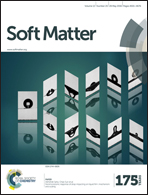Inertial and stick-slip regimes of unstable adhesive tape peeling
Abstract
We present an experimental characterization of the detachment front unstable dynamics observed during the peeling of pressure sensitive adhesives. We use an experimental set-up specifically designed to control the peeling angle θ and the peeled tape length L, while peeling an adhesive tape from a flat substrate at a constant driving velocity V. High-speed imaging allows us to report the evolution of the period and amplitude of the front oscillations, as well as the relative durations of their fast and slow phases, as a function of the control parameters V, L and θ. Our study shows that, as the driving velocity or the peeling angle increases, the oscillations of the peeling front progressively evolve from genuine “stick-slip” oscillations, made of alternating long stick phases and very brief slip phases, to sinusoidal oscillations of amplitude twice the peeling velocity. We propose a model which, taking into account the peeling angle-dependent kinetic energy cost to accelerate and decelerate the peeled tape, explains the transition from the “stick-slip” to the “inertial” regime of the dynamical instability. Using independent direct measurements of the effective fracture energy of the adhesive-substrate joint, we show that our model quantitatively accounts for the two regimes of the unstable dynamics.



 Please wait while we load your content...
Please wait while we load your content...